Movement of Earth and Weather Class 5 Notes EVS
QUICK CONCEPT REVIEW
As you already know that we live on earth. You have also studied about different things that the earth and its atmosphere provides us. We grow our food on earth. We also get many valuable things such as: coal, petroleum and water from earth. The atmosphere of earth provides us oxygen to breathe.
We already know that there is a system called solar system which comprises of the sun and all the planets. All the planets revolve around the sun. In this chapter we shall learn some more movements of earth.
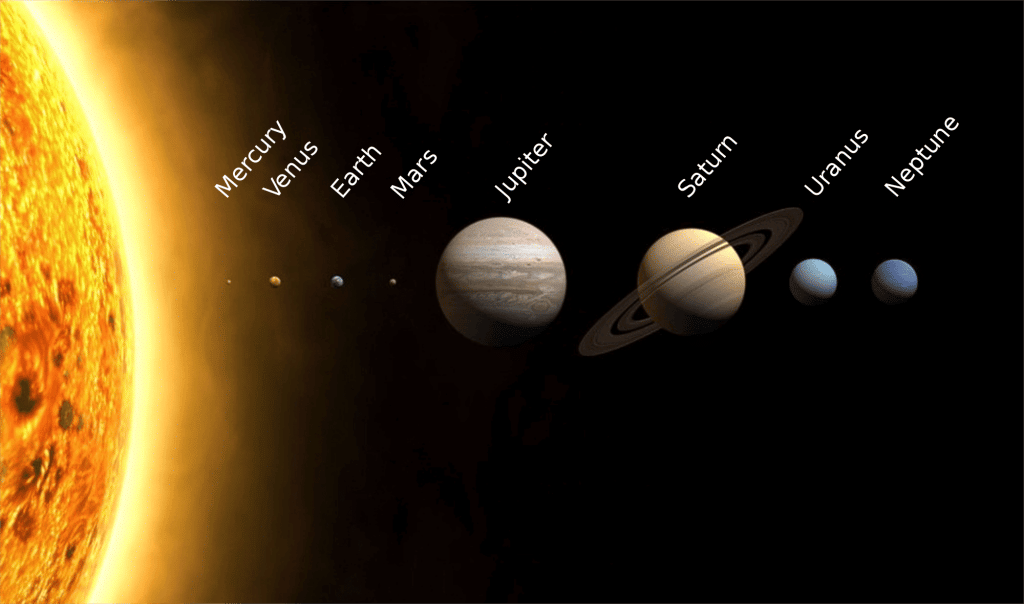
Fig: Solar System
Amazing Fact
- Northern hemisphere contains most of earth’s land area. Southern hemisphere is 99% water.
MOVEMENTS OF EARTH
Like all other planets, earth also revolves around the sun. The movement of earth around the sun is called revolution. Earth revolves from west to east in an elliptical orbit.
Therefore the distance between earth and sun keeps on changing. The earth takes one year to complete its revolution around sun.
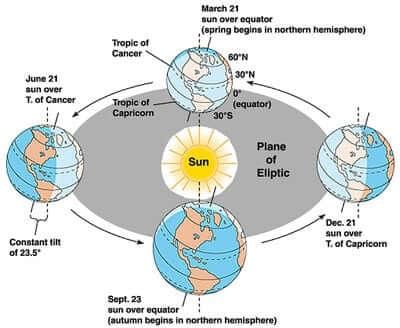
Fig: Movements of Earth
Revolution of earth is also called annual motion as the earth takes one year to complete one revolution.
Elliptical: It means an oval shape. Many heavenly bodies revolve in an elliptical path in the galaxy such as all the planets in solar system.
Orbit: It is the path followed by a planet.
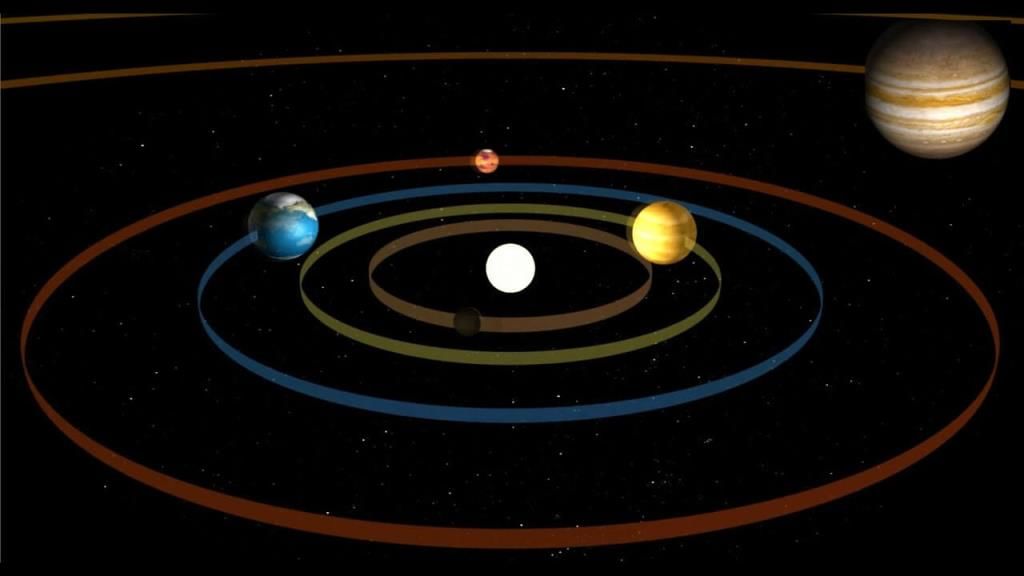
Fig: Different orbits of planets
But do you know there is one other motion associated with earth. Apart from revolving around the sun the earth also spins around itself. This spinning of earth around itself is called Rotation. The earth rotates from west to east. It completes its one rotation in 24 hours i.e. a day.
When we say that earth rotates or spins around itself, we say that it rotates on its axis. Axis is an imaginary line on which the earth rotates. It links the two poles.
What are Northern and Southern hemispheres?
Hemisphere means half of a sphere. Northern hemisphere is in north of equator whereas southern hemisphere is in south of equator. The earth is divided in these two hemispheres.
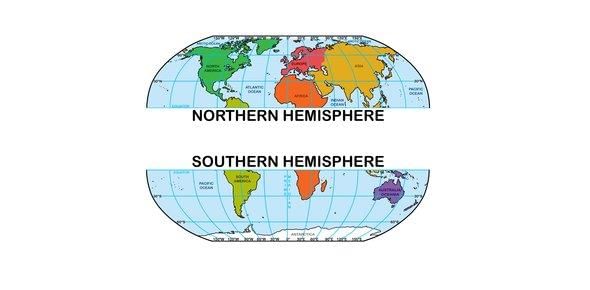
Fig: The picture indicating the northern hemisphere and the southern hemisphere
Equator: It is an imaginary line drawn around the earth equally distant from both the poles, dividing the earth into northern and southern hemispheres.
WHAT ARE NORTH AND SOUTH POLES?
The northernmost point of earth is called North Pole and the southernmost point of earth is called South Pole.
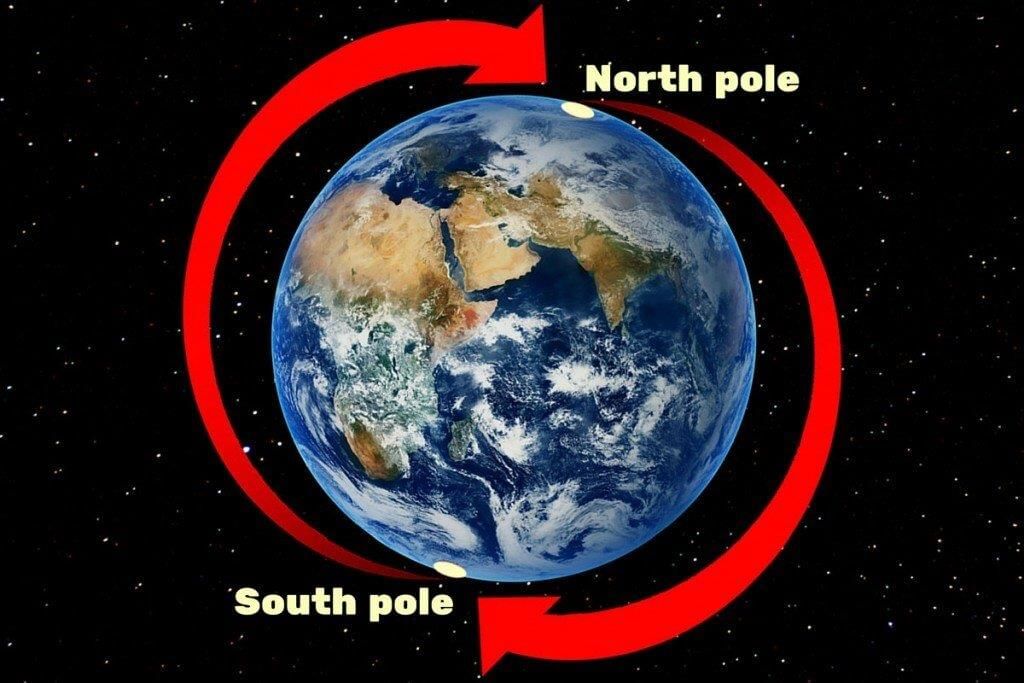
Fig: The northernmost point and the southernmost point of earth.
EFFECTS OF EARTH’S MOVEMENT
1. Day and night: You get up in the morning and there is a bright day ahead. Then slowly the evening comes and after that there is night. Have you ever thought how the day light changes into the darkness of night?
This is because of the rotation of earth around its own axis. As the earth rotates, different parts of earth come in front of sun. The part which is facing the sun gets its light whereas the other part which is away from sun does not receive the sunlight and has night. From sunrise to sunset light falls on earth and we call it day. The bright period is called the day whereas the dark part is called night.
The day and night time together is called one day.
So the day and night occurs due to the rotation of earth.
2. Seasons: Like the change in day and night you must have also seen the change in weather. Sometimes it is hot whereas after a few months there will be cold at the same place. There is also difference in weather of different places at the same time. There may be cold in your country whereas there is summer in the other country.
What could be the probable reason for change and difference in weather?
Well the answer is the revolution of earth. As studied above, you know that the earth revolves around sun. As we already know there are two hemispheres on earth. The position of a hemisphere with respect to the sun determines the type of weather on that place. During the months of May, June and July, the northern hemisphere is exposed to more sunlight hence there are summers in northern hemisphere at this time of year whereas there will be winters in southern hemisphere. Then in the months of November, December and January the weather conditions reverse.
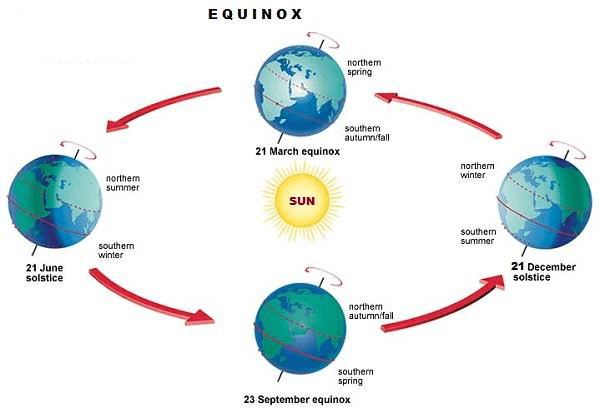
Fig: Effect of earth's movement on day and night & seasons.
So we can say that the change of seasons is due to earth's revolution around the sun. The weather of a place depends upon the heat received by that place from sun. As we know that the earth spins on its own axis. Earth's axis is not straight but tilted. Earth's tilt on axis is 23.5 degrees. So different ports of earth are tilted towards the sun at different times. This results in different seasons. The side towards sun  gets more sunlight
gets more sunlight will be warmer. The side away from sun
will be warmer. The side away from sun  gets less sunlight will be cold so now we know that the earth moves around itself and around the sun. We also know that moon revolves around the earth. This means these three heavenly bodies (sun, earth and moon) must come in a straight line some time.
gets less sunlight will be cold so now we know that the earth moves around itself and around the sun. We also know that moon revolves around the earth. This means these three heavenly bodies (sun, earth and moon) must come in a straight line some time.
ECLIPSES
While revolving around each other these three heavenly bodies (earth, sun and moon) come in one straight line. In this case one of the two (moon and earth) comes between the sun and the other. This is known as an eclipse. An eclipse occurs due to movement of shadows of earth and moon.
The word eclipse is derived from ancient Greek which means darkening of a heavenly body.
THE ECLIPSE IS OF TWO TYPES
1. Solar eclipse: This happens when moon comes between sun and the earth. In this way the moon stops the sunlight from coming on earth and as a result there is darkness during the day time.
Solar is something related to sun.
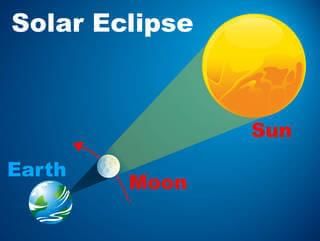
Fig: Sun, Moon, Earth line up with the moon in the middle.
2. Lunar eclipse: This happens when the earth comes between the sun and moon. Since the moon does not have its own light, but shine because of reflection of sun rays. A total lunar eclipse occurs when the earth's shadow blocks the sunlight from reaching the moon.
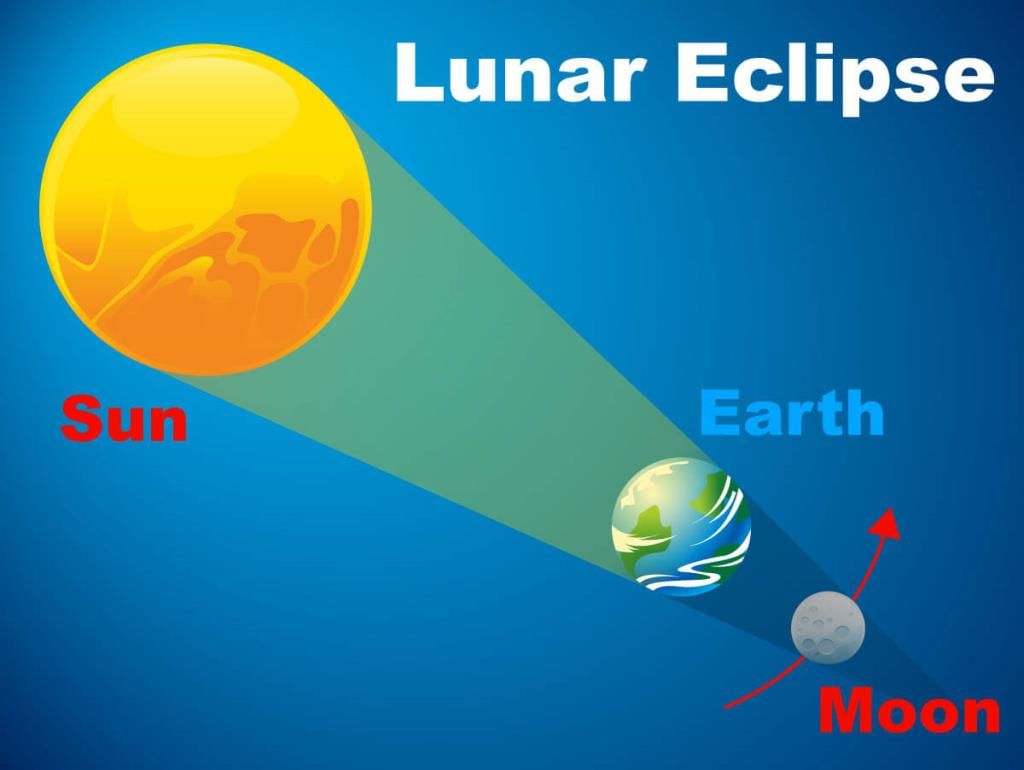
Fig: Sun, Earth, Moon line up with the earth in the middle.
There are 5 main types of eclipses:
1.Partial eclipse of sun: This occurs when partial shadow of moon sweeps the earth.
2.Annular eclipse of sun: This happens when full shade of moon is above earth.
3 Total eclipse of sun: This happens when full shadow of moon falls on earth.
4. Total eclipse of moon: This happens when full shadow of earth falls on moon.
5.Partial eclipse of moon: It happens when the partial shadow of earth falls on moon.
Always remember that sun can never come between earth and moon. This is because the moon always revolves around earth and the distance between earth and sun is much larger as compared to distance between earth and moon.
Eclipses do not occur very often because orbit of moon is tilted away from orbit of earth and these three are rarely in a line.
EFFECT OF MOON ON EARTH
The moon's gravitational force pulls the water in the oceans towards itself. This is due to gravitational forces exerted by moon and sun and rotation of earth. Moon rotates around earth and pulls all the things towards it. This gravitational force of moon causes tides.
WHAT IS A TIDE?
During one whole day, the water on the earth rises to maximum height which is known as high tide, whereas when the level of water is lowest or comes down it is known as low tide.
The part of earth which is near to moon experiences more gravitational force of moon and hence there is high tide in that part i.e. water gets pulled up, whereas the other part experiences low tide.

Fig: high tide

Fig: low tide
Generally there are two high and two low tides each day in an ocean. But some oceans experience only one high and one low tide.
So we can see that how the movement of earth and moon bring solar and lunar eclipses. And how the rotations of moon around earth bring high and low tides.
|
10 docs|23 tests
|
FAQs on Movement of Earth and Weather Class 5 Notes EVS
| 1. What causes the movement of the Earth? |  |
| 2. How does the movement of the Earth affect weather patterns? |  |
| 3. What is the significance of the tilt of the Earth's axis in weather changes? |  |
| 4. How does the Earth's revolution affect the occurrence of different seasons? |  |
| 5. How does the movement of the Earth contribute to the formation of weather phenomena like hurricanes and cyclones? |  |
















